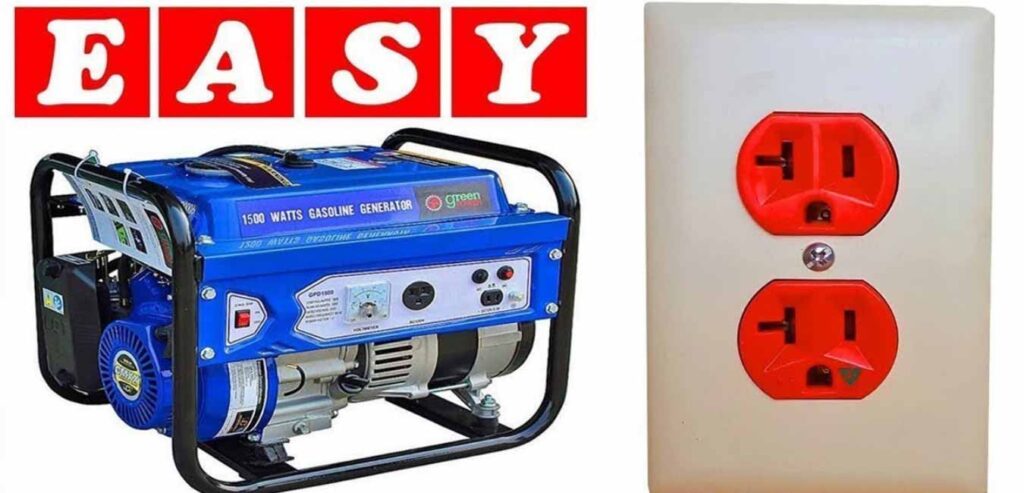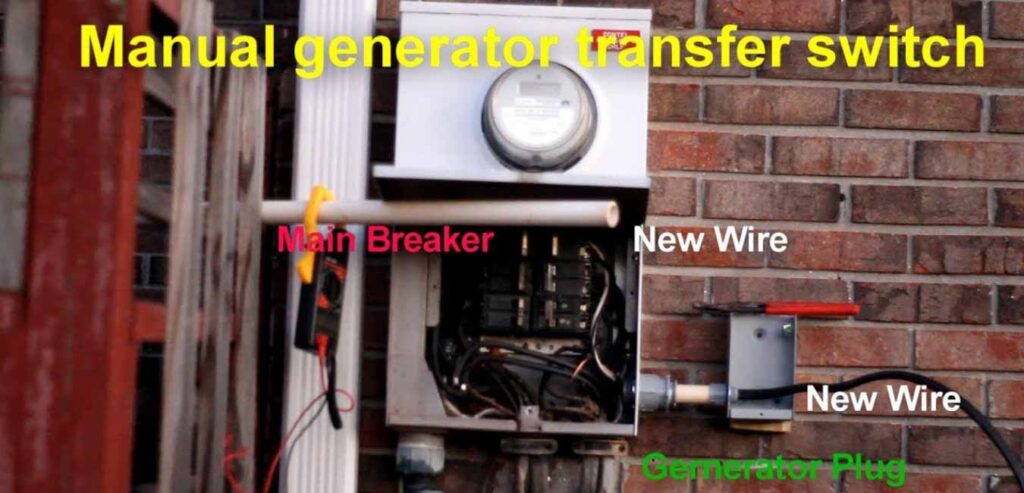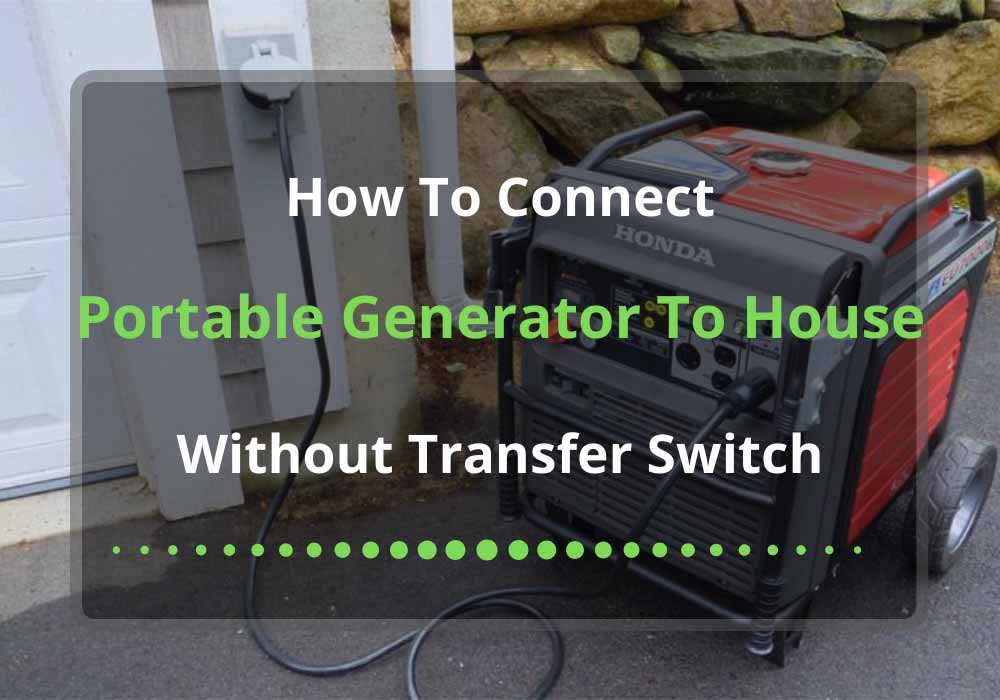A portable generator will do you a world of good in cases of emergency power outages in your home, office, or any other building. Most states require people who own portable generators to connect them to their homes using a transfer switch. These transfer switches help to isolate the power, ensuring that there is no clash or back feeding between the general power supply and the portable generator. This article will teach you how to connect a portable generator to your house without a transfer switch safely and efficiently.
To connect a portable generator to your house without a transfer switch, you need to mount a power inlet and install a circuit breaker. Then, when you have a power outage, turn on the generator after connecting it to the inlet plug.
Contents
How do You Hook up a Portable Generator to Your House?
Before you can use a portable generator in your home, you need to make sure that the original electrical connection makes room for auxiliary power. Otherwise, you might have to call an electrician to make the necessary connections available. After the house is wired, you can proceed to the next step hooking up your generator to your building.

If you’ve never used a generator before, this will be an excellent time to find the manual and read the instructions on how to use it. As a rule of thumb, your portable generator should always be at least 10 feet away from your building, especially your windows. The distance will protect you from exposure to carbon monoxide.
Prepare the Generator and Start It
All portable generators are gasoline-powered. So, you will need to pour gas into the tank if you want the gen to work. You also need to add oil to an entirely different compartment to prevent the engine from crashing.
There is a gauge to measure how much oil is enough, and there is one for gasoline too. Make sure there isn’t any visible spillage on the generator to prevent a possible fire hazard.
There are solid and reliable extension cords that can help you transmit power from a generator to your home. Get one or more for yourself in emergencies. Connect the generator to the extension cords and start it.
You should get power in your home. As long as you have a transfer switch, you shouldn’t have a problem with fire. However, what happens if you don’t have a transfer switch in your home? You will find out later.
Types Of Transfer Switches
- Automatic Transfer Switch
- Manual Transfer Switch
- Soft Transfer Application
- Closed Transition Switching
It is important to note that every transfer switch apart from the automatic one requires human intervention. This is why automatic transfer switches also happen to be the most common type in the market.
Irrespective of the option you choose, all transfer switches help to isolate the power supply in your home, ensuring that there isn’t an overload or clash between two power sources.
So, how can you ditch the power transfer switch without running the risk of an electrical disaster? Can you hook up a generator without a transfer switch?
You can set up your generator without the transfer switch, but you will have to take some safety precautions. Keep reading to find out more.
Is a Transfer Switch for a Generator Required?
Yes and no. A transfer switch is required to use a portable generator. In some countries, it is illegal to use a generator without one. However, there are ways to use your generator without a transfer switch.

Portable generators aren’t meant to be used all the time when your home is connected to the local electricity grid. They are strictly reserved for emergencies.
If you don’t have a power transfer switch when an outage occurs, you will need to manually connect the generator to a power outlet to get electricity in your house. That is the only way you can switch from the power grid to the portable generator.
With an electrical transfer switch, you can switch between the power grid and the portable generator. When you don’t use a transfer switch, you may have to plug individual appliances into the generator using a cord.
With the transfer switch, all you have to do is power the circuit panel, and everything in your house will get power.
Can You Hook up a Generator Without a Transfer Switch?
Yes, you can hook up a generator without a transfer switch if you have the right toolkit and you know what to do. Some of the things you will need are listed below.
1. Buy a Breaker Box
Most homes already have breaker boxes as part of the electrical system. However, if there isn’t enough room in your breaker box, you might need to install another one. In addition, the breaker box has to be compatible with your portable generator.
2. Get Three Different Copper Wires
You will need to buy solid and durable wires for conducting the current from your generator to your building. The more space between the gen and the building, the longer the cables should be. If you intend to keep both 12 feet apart from each other, the wires should be 12 feet long at least.
3. Purchase an Inlet Plug and Interlock Kit
The inlet plug will be attached to the wall of your building and attached to the copper wire on another end. Then the copper wire will be connected to the generator.
Generators typically come with plugs you can attach to your wire. So, there is no need to purchase a generator plug.
Since you will not be using a transfer switch, buy an interlock kit. The interlock kit does the same job as a transfer switch, but it costs less money.
Step By Step Guide to Using a Portable Generator Without a Transfer Switch
When you’ve gotten all the necessary tools and covered up with protective gear, you can start the installation by following the steps below.

1. Turn off Your Power
Whether there is a power outage or not, you need to turn off your main power before making any electrical adjustments in your home. The last thing you want is for power to be restored when you’re still working on the installation.
2. Drill a Hole
If you have a power drill at home, you should use it to drill a hole in the access point. The hole should not be too broad, just wide enough for the copper wire to fit. Drill with precision and make sure the hole isn’t in a place that will affect the structural integrity of your home.
3. Install the Inlet Plug
About 2 to 3 feet away from the hole you drilled, install the inlet plug. You may need a screwdriver for the installation. Make sure the inlet is firmly mounted on the wall before you proceed to the next step.
4. Set up the Wires
After mounting the inlet plug, you need to set up the wires securely. Secure the wires one by one as you assemble the conduit. Make sure that everything is right and there isn’t any naked wire hanging out.
5. Install Your Breaker
When you’re done with the inlet plug, open the new or existing breaker box and connect it to the inlet plug. After that, you can put on your portable generator to test and see if it works. After you are on the gen, plug the wire from the gen into your inlet plug to get power.
Is It Unsafe to Connect a Generator to a House Without a Transfer Switch?
No, it is not safe to connect your home to a generator without a transfer switch. Connecting your home directly without anything to balance out the power will increase the risk of back-feeding. Backfeeding can lead to electrocution or a fire outbreak. This is why it is illegal in most countries. So, if you don’t want to use a transfer switch, make sure that you follow the steps above to provide some buffer and enable smooth transfer. This reduces the risk of back-feeding and other possible electrical disasters significantly.
Safety Measures for Connecting Your Generator
The best safety measure you should take when connecting your generator is wearing protective gear. These include:
- Working rubber gloves to protect your hands from possible electric shock
- Ground yourself with a working boot with steel-capped tips
- Wear protective eyewear with a rubber frame
- Always keep a voltage stick handy to check the electrical outlet for power
Apart from protecting yourself, it would help if you took precautions to prevent damage to life and property in your home. Ensure that the generator is always placed at a safe distance. It should be in your compound but away from your windows and doors.
Make sure that the generator is covered while leaving room for the carbon monoxide to escape.
All breakers and outlets should be outside your building but not exposed to the elements like rain, sunlight, and snow.
Finally, you should only attempt to install the interlock and power inlet on your own if you have real experience. Otherwise, seek out a professional electrician to do it for you. Doing it yourself when you don’t have any prior experience might cost you more in the long run.
Final Thoughts
It’s not advisable to use a portable generator without a transfer switch. However, it is not impossible. If you do the right thing, you can use your generator without the regular transfer outlets. Just make sure it is not illegal in your location and the connection is correct to avoid an electrical disaster.